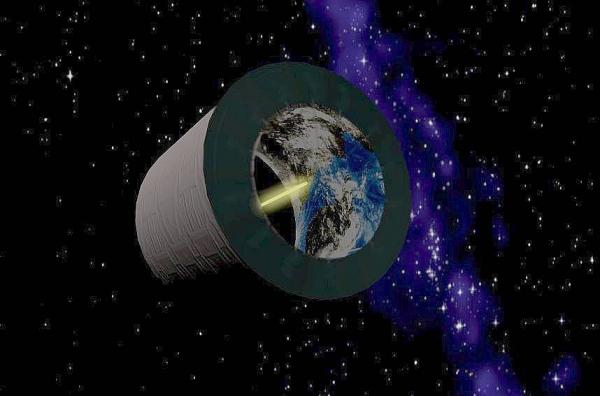BY LETTER
Worldrings
Technology > Application > Envirotech
Technology > Technology Levels > High Tech / Hitech
Technology > Application > Infrastructure
Technology > Application > Megascale Engineering
Technology > Technology Levels > High Tech / Hitech
Technology > Application > Infrastructure
Technology > Application > Megascale Engineering
 Image from Steve Bowers | |
| A worldring has a similar surface area to a Gaian-type planet; it is sometimes called 'a world turned inside-out' | |
World Rings, as the name implies, are ring-type habitats which duplicate (as much as possible) all the conditions found on a Gaian type world, including total surface area under full centrifugal gravity. As such, World Rings occupy the middle ground between Bishop Rings and Banks Orbitals, and typically use technology from both.
Because a World Ring's radius is much larger than that of a Bishop Ring, carbon nanotube is not strong enough to overcome the hoop stress under full centrifugal gravity so some amount of magcarbon cabling is needed. To minimize the amount of costly magmatter World Rings are typically constructed like a radial tyre: Rings of magcarbon cables are run along the tops of the rimwall, like the beads of said tyre, while the more conventional carbon nanotube cables are laid across the ring, at 90 degrees to the direction of spin, from bead to bead. In most other aspects the World Ring will be constructed as a Bishop Ring or Banks Orbital would.
The greatest concentration of World Rings can be found in the Terragen Federation system of Magal (home system of House Magal). There more than a hundred rings may be found, each depicting a different era of Old Earth's past history, or eras from the legends and tales of that world. Some worldrings depict speculative alternate present or future scenarios. Each Magal ring has a second, smaller counterotating ring inside to help maintain stability.
There is a second type of World Ring, one that does not need magmatter and can therefore be built by modosophont-ruled polities. This type of World Ring is actually more like a small topopolis; a torus that rotates around the long axis of its small circle rather than the short axis of its large circle. The smaller (tube) diameter of the torus can be any size the polity has the tech for but to be classed as a World Ring the larger (ring) diameter has to be great enough to provide a total surface area equal to that of a Gaian type world under full centrifugal gravity. For example, the combined surface area of 163 Bishop Rings (1,000 kilometres radius and 500 kilometres width) is equivalent to that of Old Earth. If these were stacked, and looped, the torus would be almost 30,000 kilometres across but the biosphere would not be continuous. On the other hand, if a small topopolis were placed around Old Earth in a geostationary orbit it would only need to have a "tube" radius of 306 kilometres to equal the surface area of the world below it. As can be seen, with this type of habitat a larger ring diameter results in a smaller tube diameter which allows for greater engineering freedom; there is a wider choice in the materials (such as Pandifico) and/or technologies that can be used to overcome such problems as deformation or kinking. Indeed, at the smallest tube diameters it is even possible to replace short segments of the tube with materials that don't just stretch, as the ring's inside circumference becomes its outside circumference, but actively expands and/or contracts to drive the tube's rotation.
Related Articles
Appears in Topics
Development Notes
Text by AI Vin
Initially published on 20 November 2010.
Initially published on 20 November 2010.






